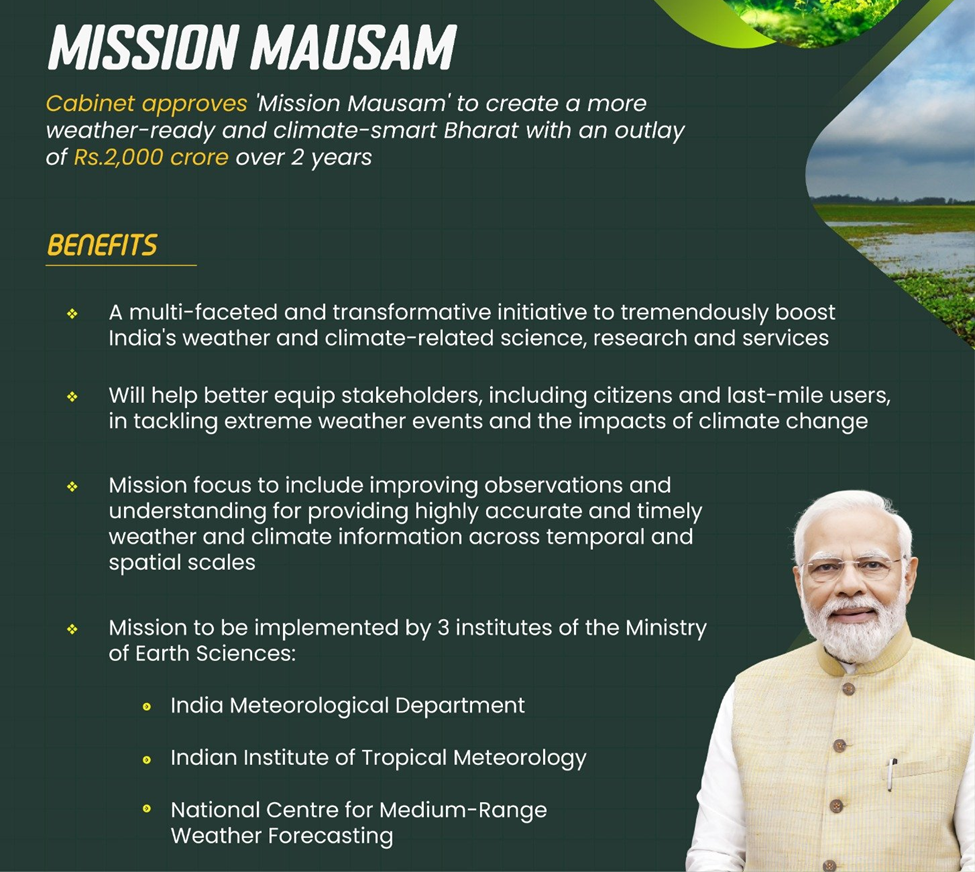Context:
The increasing frequency and intensity of climate-related events in India highlight the urgent need for better weather forecasting systems. The monsoon season, which is crucial for Indian agriculture, has become increasingly unpredictable. The 2023 monsoon season was particularly challenging, with severe flooding affecting several states and disrupting both livelihoods and infrastructure.
· Research by the Council on Energy, Environment and Water (CEEW) indicates that about 40% of India’s districts are now exposed to alternating climate hazards, where areas prone to flooding may also experience drought during dry periods. This combination of risks is concerning, especially considering that there has been a significant rise—up to 64%—in the number of days with heavy rainfall during the monsoon over the past decade, based on an analysis of 40 years of rainfall data.
Need for Enhanced Weather Forecasting:
· Nearly two-thirds of India’s population is exposed to flood risks, yet only one-third of those in flood-prone regions are covered by early warning systems. This stark contrast with cyclone early warning systems— which cover all cyclone-prone areas—underscores the urgent need for improved weather forecasting capabilities to address the growing threats posed by extreme weather events.
· Recognizing these challenges, the Union government approved Mission Mausam in September 2024. This ambitious initiative aims to enhance India's weather observation network, improve forecasting models, and explore weather modification techniques.
· It will be primarily implemented by three institutions under the Ministry of Earth Sciences: the India Meteorological Department (IMD), the National Centre for Medium Range Weather Forecasting (NCMRWF), and the Indian Institute of Tropical Meteorology (IITM). The ₹2,000 crore initiatives seeks to augment weather observation using various instruments and improve forecasting through enhanced understanding of atmospheric physics and the integration of machine-learning approaches.

Key Focus Areas of Mission Mausam:
1. Expansion of Forecasting Capabilities:
o Install Weather Observation Platforms: Prioritize installation along India's western coast and in urban centers at high risk of climate-related events. Currently, India has only 39 Doppler Weather Radars (DWRs), with a limited number covering critical areas. For example, cities like Ahmedabad, Bengaluru, and Jodhpur, which have faced severe flooding, lack sufficient radar coverage.
2. Open Access to Weather Data:
o Ensure that weather data is freely available for researchers and entrepreneurs to foster innovation. This open access can help analyze trends and develop localized early warning tools. Countries like the US and UK have successfully made their weather data publicly accessible, resulting in the development of various analytical tools to support local governance.
3. Improved Communication of Weather Warnings:
o Enhance communication tools for disseminating weather warnings. While the IMD provides district-wise weather warnings via web and mobile applications, user experience can be further improved. Educating users on how to interpret these warnings through informative videos and guides will help them act effectively in response to weather alerts.
Successes of Weather Forecasting in India:
Weather forecasting in India has undergone significant advancements in recent years, leading to improved accuracy, timely predictions, and enhanced disaster management capabilities. The following key successes highlight the remarkable progress made in this vital field:
1. Improved Cyclone Forecast System
The timely and accurate forecasts of cyclones in India have led to the establishment of a reliable response and evacuation mechanism.
o For instance, the accurate predictions of Cyclone Phailin in 2013 and Cyclone Amphan in 2020 played crucial roles in avoiding the loss of thousands of human lives. The ability to forecast cyclones effectively has empowered authorities to implement precautionary measures, ensuring the safety of vulnerable populations in coastal regions.
2. Monsoon Prediction
The long-range monsoon forecasts provided by meteorological agencies have achieved near 100% accuracy over the last decade. This remarkable success is essential for India, where agriculture heavily depends on monsoon rains. Accurate monsoon predictions allow farmers to plan their planting and harvesting activities accordingly, contributing to increased agricultural productivity and food security.
3. Weather Forecasting for Transportation
The Winter Fog Experiment (WIFEX), developed by the India Meteorological Department (IMD), has significantly improved the dissemination of fog information. This initiative is crucial for airlines and passengers, as it aids in planning travel during winter months when fog conditions can severely disrupt air traffic. The provision of timely and accurate fog forecasts enhances safety and reduces delays, thereby improving the overall efficiency of transportation services.
4. Air Quality Monitoring
The IMD’s System of Air Quality and Weather Forecasting and Research (SAFAR) is being utilized to monitor air pollution levels in major cities, including Delhi.
o This system provides real-time data on air quality, helping authorities and citizens understand pollution levels and take necessary precautions. By raising awareness about air quality issues, SAFAR contributes to public health initiatives and environmental protection efforts.
5. Enhanced India’s Global Reputation
The IMD has been recognized as one of the six Regional Specialized Meteorological Centres by the World Meteorological Organization (WMO).
o Additionally, the IMD has contributed to the United Nations’ ‘Early Warning for All’ program concerning climate change, reinforcing its role in international climate efforts.
Current Gaps in Weather Monitoring:
· Radar Coverage Limitations: India currently operates 39 Doppler Weather Radars (DWRs) to monitor rainfall, with limited coverage in high-risk areas.
o For instance, only five radars are stationed along the entire western coast, while key cities like Ahmedabad, Bengaluru, and Jodhpur lack radar installations despite experiencing recurrent flooding.
o The growing frequency and intensity of cyclones in the Arabian Sea further necessitate the immediate installation of additional weather monitoring systems in vulnerable locations.
· Data Accessibility Challenges: Open access to weather data is vital for developing localized analytical tools. While the IMD provides data through its supply portal, there are significant restrictions on data volume and accessibility.
o In contrast, countries like the United States, the United Kingdom, and France provide open access to their weather data, enabling researchers and entrepreneurs to create innovative tools that assist local governments in disaster preparedness and response.
· Need for Enhanced User Engagement: While the IMD has developed a robust web application that delivers district-wise weather warnings, the user experience remains suboptimal. There is a need to improve how weather warnings are communicated to the public, providing guidance on interpreting these warnings effectively. 'Mission Mausam' should focus on enhancing users' understanding of weather information through informative resources like videos and media.
Conclusion:
Mission Mausam represents a timely and necessary response by the Indian government to the growing threat of extreme weather events. By expanding the observational network and enhancing forecasting capabilities, the initiative has the potential to revolutionize how weather information is disseminated and understood across the country. As India grapples with the adverse impacts of climate change, improving weather forecasting is not merely an option; it is an imperative for safeguarding lives and livelihoods in an increasingly uncertain climate landscape.
| Probable questions for UPSC Mains exam: Assess the impact of climate change on weather patterns in India. How should government policies adapt to mitigate the effects of extreme weather events on agriculture, infrastructure, and public health? |







